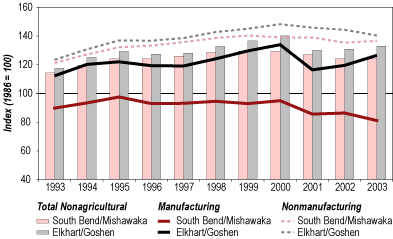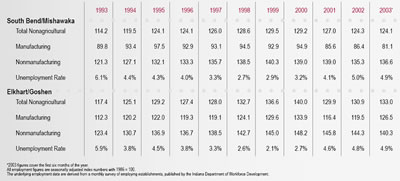South Bend/Mishawaka and Elkhart/Goshen
Professor of Economics, Indiana University South Bend
Professor of Economics, Indiana University South Bend
To help understand how we came to where we are today, Table 1 and Figure 1 chart the longer term progress of the Michiana region, of which South Bend/Mishawaka and Elkhart/Goshen are a major part. The index numbers in Table 1 and Figure 1 use 1986 as the base period and employ monthly averages of seasonally adjusted index numbers. They highlight how much the growth, volatility, and nature of the Elkhart/Goshen and South Bend/Mishawaka economies have differed over the past decade. For example, the South Bend/Mishawaka economy’s growth (as measured by employment) over the past decade has mirrored that of the State of Indiana. Indeed, the patterns of growth—the strong expansion from 1993 to 1996, followed by a period of more moderate growth from 1996 to 2000, and then a period of declining employment from 2000 to 2002—are nearly identical for South Bend/Mishawaka and the State of Indiana. In comparison, Elkhart/Goshen grew more rapidly than South Bend/Mishawaka and the State of Indiana during the1993 to 1996 and 1998 to 2000 periods, declined more sharply from 2000 to 2001, and has started to rebound more strongly since then.
Table 1
Indexed Employment and Unemployment Rates, 1993 to 2003
Basic Industries
These contrasting results largely reflect the diversity of South Bend/Mishawaka and Elkhart/Goshen’s basic industries. Basic industries produce goods or services that are purchased by buyers outside the metropolitan statistical area (MSA), and in the short-term, a smaller economy’s basic industries tend to be the driving force that determines its growth or decline. All eleven of Indiana’s metropolitan areas are sensitive to the ups and downs of manufacturing industries, particularly to the transportation equipment sector (SIC 37). But for Elkhart/Goshen, manufacturing represents one-half of its total employment and constitutes virtually all of its basic employment. It follows, as seen in Table 1 and Figure 1, that strong overall employment growth or decline in Elkhart/Goshen closely parallels periods of growth or decline in recreational vehicles, manufactured housing, band instruments, and other Elkhart/Goshen-based manufacturing industries. Manufacturing in South Bend/Mishawaka, on the other hand, accounts for only about one-sixth of its total employment and onehalf of its basic employment; and South Bend/Mishawaka’s employment growth thus depends on a much broader range of basic activities.
Figure 1
Employment Index for South Bend/Mishawaka and Elkhart/Goshen

Research on South Bend/Mishawaka’s basic industries reveals that, in addition to various manufacturing industries, South Bend/Mishawaka’s major basic industries include medical care services, business services, a variety of retail services, higher education services, and services related to tourism (such as services to fans who come to South Bend/Mishawaka for Notre Dame football games or conventions). Some of these buyers, for example those who come to South Bend for higher education, arrive from all corners of the United States, as well as from many international countries. Other buyers, who reside in the surrounding Michiana area, travel to South Bend/Mishawaka to shop at its various shopping malls, to dine at its restaurants, or to consult its medical specialists. Many of South Bend/Mishawaka’s outside buyers drive over from Elkhart/Goshen; and workers commute to and from Elkhart/Goshen and South Bend/Mishawaka—activities that bring about significant linkages between the two economies. Indeed, in the 2002 tax year, nearly 9,900 workers commuted from South Bend/Mishawaka to Elkhart/Goshen, whereas about 3,300 other workers commuted in the opposite direction. Though the data break out the South Bend/Mishawaka and Elkhart/Goshen economies, it is better to think of these economies as highly interdependent in both consumption and production.
Employment
The more recent data in Table 1 and Figure 1 show some similarities and some differences when compared to earlier years. Total nonagricultural employment evidenced weakness during 2002 for both the South Bend/Mishawaka and Elkhart/Goshen economies, continuing the decline that began in 2000 and persisted throughout 2001. In 2002, Elkhart County’s nonagricultural total employment grew by 0.8 percent and St. Joseph County’s nonagricultural total employment decreased by 2.1 percent. Both of these local growth rates were in line with national and state total nonagricultural growth rates of 0.9 percent and 1.2 percent, respectively.
In contrast to the national and state economies, where manufacturing employment continued to contract, manufacturing employment in South Bend/Mishawaka and Elkhart/Goshen grew by 1.0 percent and 2.7 percent, respectively. This upsurge derived largely from the growth in transportation equipment (SIC 37). In South Bend/Mishawaka, transportation equipment remained strong throughout the entire year, ending the period with an 11 percent increase (500 more jobs). This upswing likely resulted from the strong sales of the Hummer H2 sport utility vehicle. A decline in manufacturing employment in South Bend/Mishawaka’s other durable and nondurable manufacturing industries offset some of these gains, however. In Elkhart/Goshen, SIC 37 increased from December 2001 to December 2002 by 5,200 jobs—a 24.8 percent boost that primarily reflects the robustness of the recreational vehicle market during much of 2002.
During 2002, nonmanufacturing employment shrank in both South Bend/Mishawaka and Elkhart/Goshen by 2.6 percent and 1.1 percent, respectively. These contractions were broadbased, covering the wholesale, retail, and service sectors. Wholesale and retail trade employment fell in both economies by about 5 percent, with professional services, health care services, and other services also suffering setbacks. Nonmanufacturing employment also diminished in the nation and state, but these declines were smaller than those experienced by the local economies.
The most recent data from the Indiana Department of Workforce Development (through August 2003) indicate lingering weakness in the national, state, and South Bend/Mishawaka economies but strong growth in the Elkhart/Goshen economy. The South Bend/Mishawaka economy continues to lose jobs in the nonmanufacturing trade and service sectors. Elkhart/Goshen, however, has experienced strong gains in both the manufacturing and nonmanufacturing sectors. The Elkhart/Goshen advances in manufacturing again reflect the enduring strength of the recreational vehicle market. Though the recreational vehicle market suffered weakness in the early part of 2003, a downturn that most experts attribute to the uncertainties related to the Iraqi war, the industry has rebounded strongly throughout the summer months. In addition, modular home sales in August 2003 have also been running ahead of August 2002 sales, implying strength in this sector and contributing to Elkhart/Goshen’s strong showing in 2003.
Outlook
Accurately forecasting economic conditions for local economies is very difficult for two reasons. First, we have much less economic information available for local economies than for larger economies, and the data we do have tend to be less accurate. Secondly, special situations affecting individual firms, which would have little impact on a regional or national forecast, can have a major impact on a local economy. The uncertainty surrounding these special situations creates uncertainty about the forecast. At the present time we have several special situations that have the potential to impact our local economies over the next couple of years.
In the fall of 2003, the A.J. Wright distribution center in South Bend started hiring for 150 jobs. A.J. Wright is a relatively new and growing discount retail chain with ninety-five stores nationwide. The stores sell apparel, home furnishings, footwear, and giftware targeting moderate income customers. TJX, the parent company, hopes to build A.J. Wright into a one thousand store chain, with the South Bend center distributing products to its Midwestern stores. The 150 jobs are the first of a total of 800 jobs that will be hired if things go as planned. Since almost all of the income for these jobs comes from outside our area and no local jobs will be lost, the multiplier effect will be substantial.
The University of Notre Dame announced in the fall of 2003 that it would proceed with approximately $100 million in construction projects. The projects had been on hold for about a year due to the recession and its impact on the stock market. Since the funding for these projects comes from outside the community (the university’s endowment), this spending will also have a substantial multiplier effect during the construction phase.
For the last couple of years, the manufactured housing industry has been in a serious slump. In 1999, the industry nationwide shipped 348,000 units. In 2002, the industry nationwide shipped 168,500 units, and this year shipments are at a 135,000 unit pace.
Several factors have helped to increase the severity of the slump:
- A large number of repossessed homes
- Rising inventories
- The failure of a major financing firm
This is an important industry in our area and the negative multiplier effect has been substantial. The slump contributed to the large drop in jobs in 2000 and 2001. It appears that the industry is stabilizing and we are hoping for a recovery beginning in 2004. The drop in inventories, along with recent increases in real GDP, consumer confidence, and employment, should bolster the demand for durable goods, including manufactured housing.
The recession hit the recreational vehicle industry hard, as shipments nationwide fell from 321,000 units in 1999 to 300,000 in 2000 and 257,000 in 2001, but the industry has recovered quickly. In 2002, shipments increased to 311,000, an increase of 20 percent, and the second highest level of shipments since 1999. The industry will have the third highest level of shipments in 2003 with nearly 308,000 shipments projected. Several factors contributed to this rapid recovery:
- Very low interest rates
- Strong consumer demographics
- Changes in recreational travel
- Increasing consumer confidence
- A recovering economy
Since these factors will continue in 2004, we expect the level of RV shipments to be in the 310,000 to 315,000 range, which would be the second highest just below the 321,000 in 1999.
Indiana produces more than 50 percent of the recreational vehicles shipped nationwide and most of these vehicles are produced in northern Indiana. One example of the positive impact on our local economy is the new Coachman factory in Middlebury, which will employ approximately three hundred workers. Since these vehicles are sold nationwide, the multiplier effect of increased production is strong. The RV industry has had an important positive impact on our local economy’s recovery from the recession.
Like most local economies, the South Bend/Mishawaka and Elkhart/Goshen economies are greatly influenced by the national economy. The durable goods component of the national economy is important as automobiles, recreational vehicles, manufactured housing, and steel industries are major employers. The Elkhart economy, with its substantial manufacturing employment, is especially tied to the national economy. The national forecast calls for real GDP growth of 4 percent, low interest rates, low inflation, increased consumer spending, and increased employment. This optimistic outlook should lead to continued growth in both local economies. We should see reasonable growth in employment and a reduction in the unemployment rates to the 3.5 percent to 4.5 percent range during the year, with lower rates near the end of the year.
Also in this Issue…
- Outlook for 2004
- The U.S. Economy
- The International Economy
- Financial Forecast
- Corporate Governance and Reporting
- Housing
- Indiana
- Anderson
- Bloomington
- Columbus
- Evansville
- Fort Wayne
- Gary
- Indianapolis
- Kokomo
- Lafayette
- Muncie
- New Albany
- Richmond
- South Bend/Mishawaka and Elkhart/Goshen
- Terre Haute
- Outlook Summary for 2004




